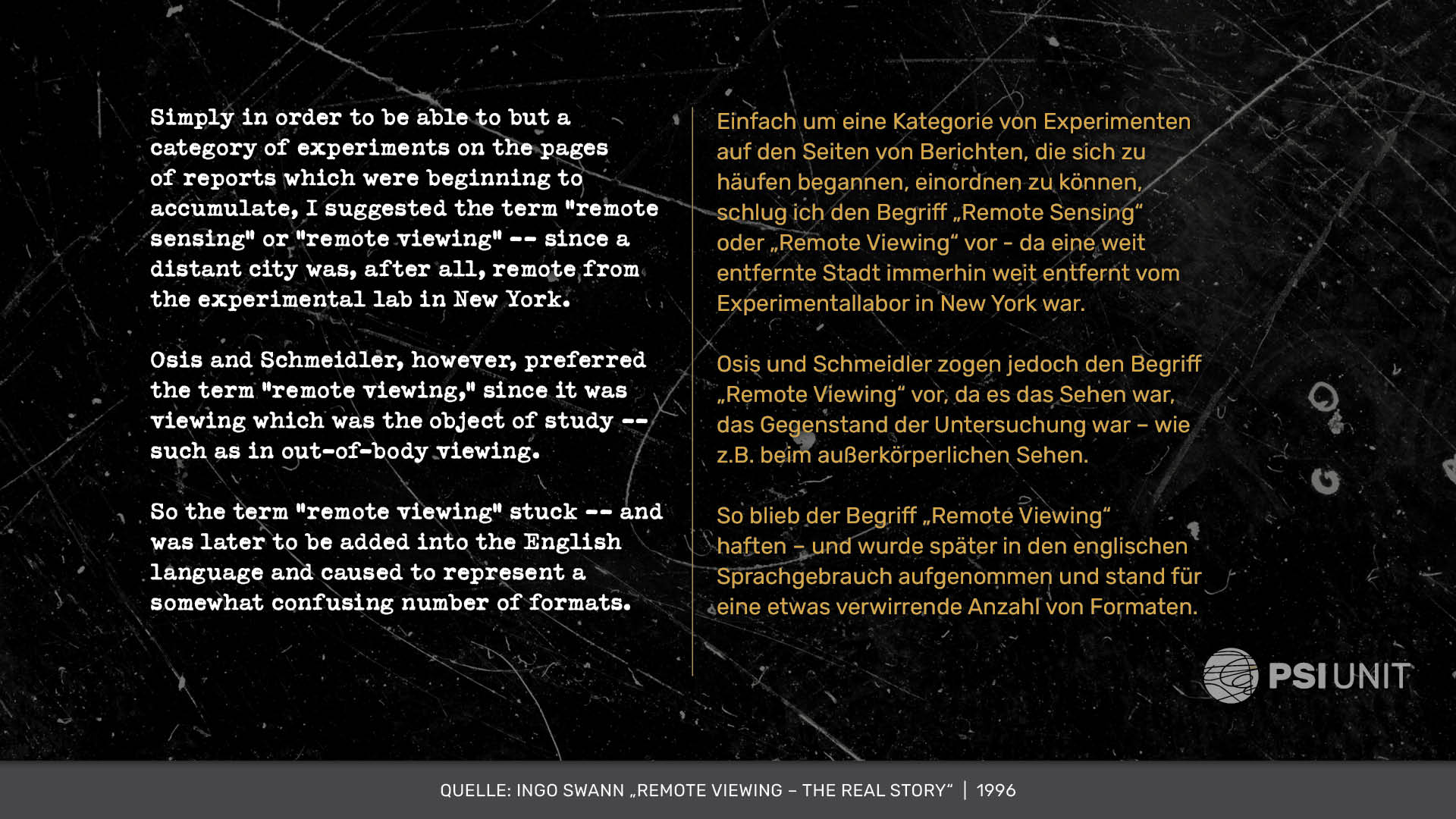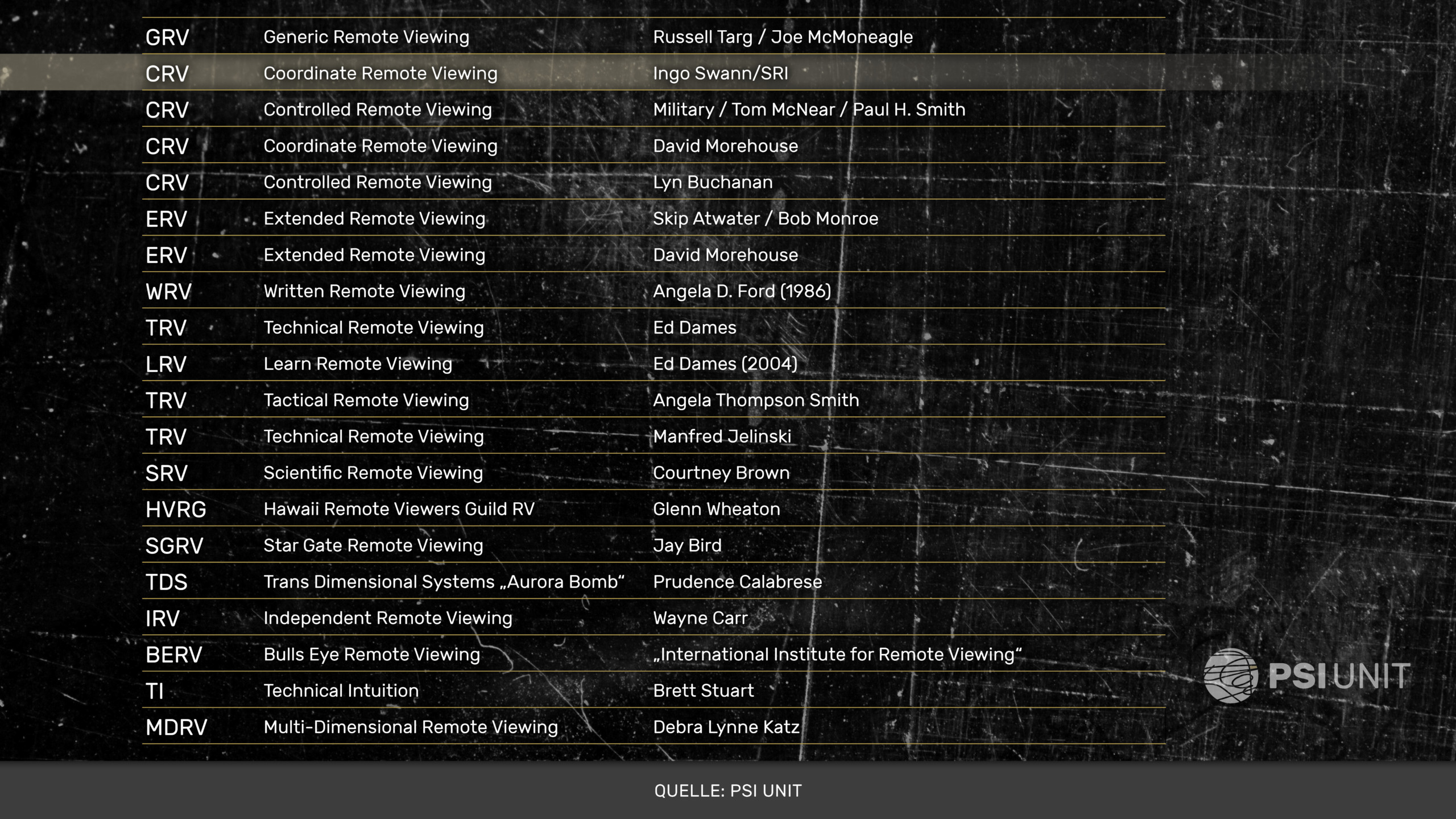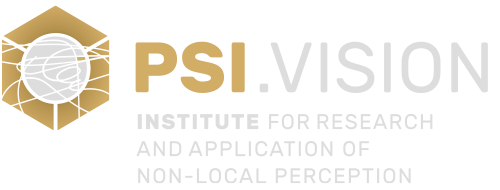Remote Viewing and the protocols
The pure definition states that remote viewing is the ability to obtain information about things (places, people, events) that are not accessible to the normal senses, for example when we are separated in space, time or by shielding. This definition only says something about the ability of the human mind, not about the means that are used for it.
The term “Remote Viewing” was coined by Ingo Swann in 1971 [1] and later used by him and the researchers at SRI to distinguish a technique of “controlled clairvoyance” from the traditional forms of Extra-Sensory Perception (ESP).

Fig. 1: Ingo Swann: The Real Story of Remote Viewing “, chap. 16, p. 124
Download as PDF on the official website of Ingo Swann , Direct link to download here .
One of the most important characteristics of remote viewing compared to other techniques is the development of a self-control of the “mental noise”. In (so-called) traditional ESP, one of the biggest problems has always been the mixing of “real” mediumistic signals and impressions projected over them by one’s own mind, which tends to then be a scattered mixture of ones own experiences, ideas and signal line information. An evolutionarily absolutely sensible program for survival, but it actively prevents the perceiver from simply reproducing unevaluated and neutral data fragments. The exact emergence of this “mental noise” – remote viewers refer to it as “analytic overlay” or AOL – and, based on this, the development of strategies to avoid it, was the research topic of the developers of today’s remote viewing methods.
Two trusted types of remote viewing were developed in the 1980s and later used in the military unit in Ft. Meade practically, both of which deal with the AOL problem in different ways.
The first of these, ERV or “extended remote viewing,” was based on traditional relaxation and meditation techniques whose goal was to suppress consciousness almost to the edge of sleep, thereby promoting a deeper connection with the medial “signal” and minimizing mental “noise.” ERV is related to GRV (Generic Remote Viewing), the working method of the first remote viewers in the scientific research series on ESP at the Stanford Research Institute. [2]
Because the viewer is in a deeper state of relaxation (theta state) during this technique, an interviewer, later called a monitor, was used to guide the session and elicit the information. The viewer then made sketches. The sessions were mostly recorded as audio and later transcribed. [3]
The second technique was also developed at the renowned California think tank SRI-International, led by Ingo Swann in collaboration with Harold E. Puthoff and Russell Targ as research directors. This method became known as Coordinate Remote Viewing (CRV). In CRV, the viewer remains in the alpha brainwave state with near full consciousness, sitting upright at a table and accessing the “medial signal” through a series of rigorous protocols that embed techniques to remove mental noise. The viewer continuously notes the received data on paper during the session. With CRV you can work with or without a monitor, as the protocol structure itself takes on all important functions.
[2] The designation GRV was coined by Paul H. Smith afterwards for the RV techniques before the military application.
[3] As Bill Ray tells in an interview with PSI unit, two secretaries were busy at the same time with the not exactly easy task of transcribing the sentences that were mumbled in a deep state of relaxation.
“Although impressive results were obtained with ERV, CRV produced quality information more consistently and predictably, and so became the predominant technique employed at Ft. Meade during the program’s most pivotal years.” [4]
The CRV method “Controlled Remote Viewing” was originally called “Coordinate Remote Viewing”, named after addressing the target by a numerical coordinate. These were first geocoordinates, then virtual number combinations, and this is how it is used to this day. This development made it possible to guarantee that the viewer is completely blinded to the target. Working with blind or double-blind sessions allowed for a scientifically traceable evaluation of the data and was also an additional safeguard against unintended AOL and pre-assumptions in the viewer.

In today’s civil use of remote viewing, these last two “technical Additions ”(i.e. working with a number coordinate and blinding the viewer) retrospectively to the definition of remote viewing that is commonly used today – which is not wrong, but does not really get to the point. John Herlosky uses a good formulation:
“Psi, psychic functioning, clairvoyance, and ESP are natural psychic ability. You are born with as much as you’re going to get.
Remote viewing is a protocol and a methodology. It can’t do any psychic functioning if you don’t already have your inherent psychic ability. Remote viewing is totally a man artificial creation, a methodology. It has to be learned. If you have the psychic ability of a hammer, it won’t matter how much or how well you learn the above, it won’t make you psychic, and it won’t make you a remote viewer either, since, without the ability, the methodology and the protocols mean nothing. And that is what is remote viewing.” [5]
[5] Quote from John Herlosky, Remote Viewing: definition, protocol, and corollaries
In the practical application of remote viewing as a tool for information gathering, the question of the reliability of the information is important. The results of a session are never 100% correct, so what information can you rely on? After all, real-world applications are open questions that no one can pull a photo out of a closed envelope to clarify.
In the days of the Stargate program, viewer information never stood alone, but was supplemented by and cross-checked with other intelligence information channels.
In today’s civilian application, the problem is different, because to reconcile the open questions, in most cases only further RV sessions are possible. First of all, it is obvious: What several viewers (blindly) bring in matching information is most likely correct.
A small but noteworthy footnote to this logic is the unanswered questions about the theory of the “telepathic overlay” as described by Ingo Swann in an essay dated Feb. 4, 1996. [6] Many remote viewers have already presented their experiences and views on this, but to our knowledge there has not yet been any scientific evidence. Some claim that the phenomenon does not exist, others attribute the theory to practical experience. Paul H. Smith thinks that telepathic overlay could most likely be a topic of the Tasker, especially when it comes to non-existent or very emotionally charged targets, such as in the esoteric area. In this way, the personal assumptions of the tasker could be picked up by the viewer if the viewer does not get a suitable signal from the actual target.
 At the PSI.vision Institute At the moment there is a small series of experiments on this subject, maybe we will be able to contribute a little to the resolution of the open questions.
At the PSI.vision Institute At the moment there is a small series of experiments on this subject, maybe we will be able to contribute a little to the resolution of the open questions.

[7] PDF download: Excerpt from the book by PSI.vision Institute with the German translation of the article by Ingo Swann “ Telepathic Overlay “




